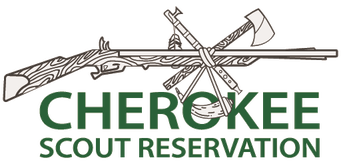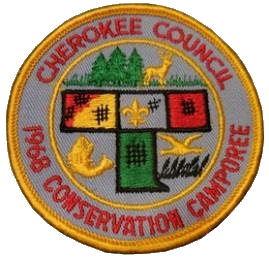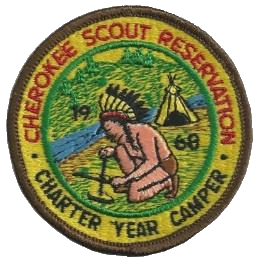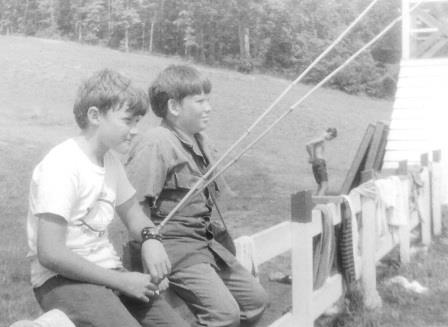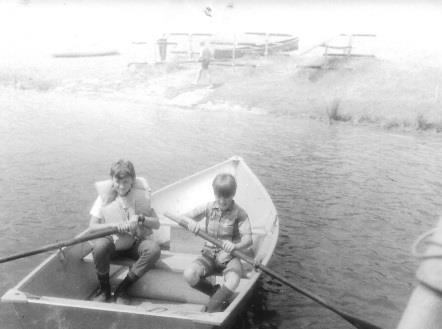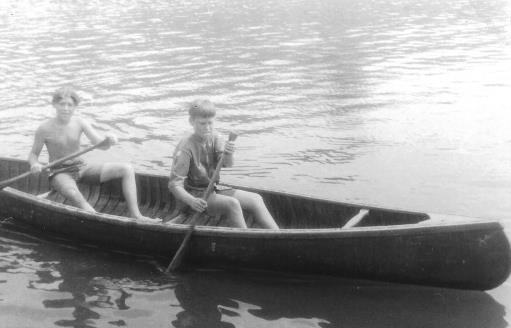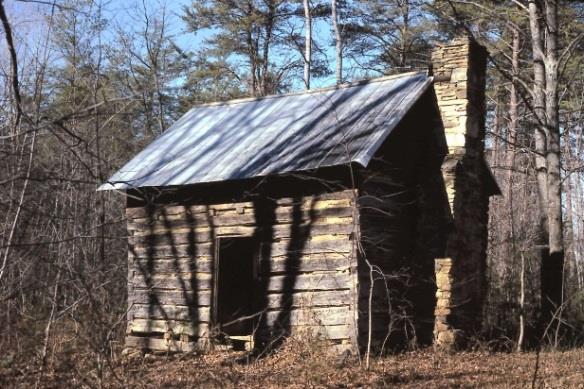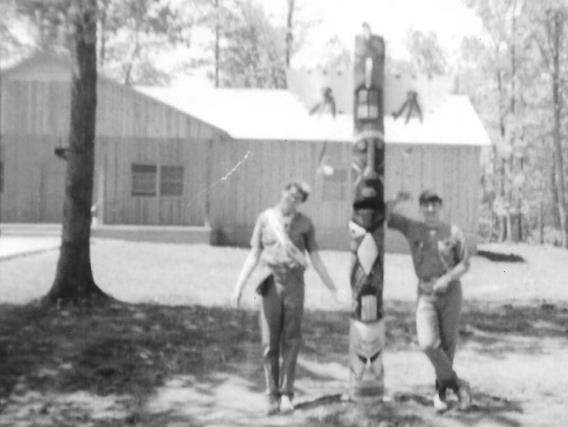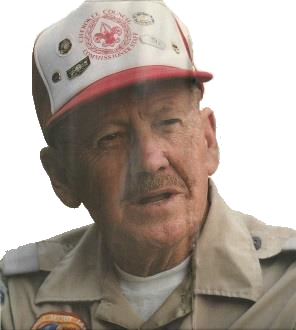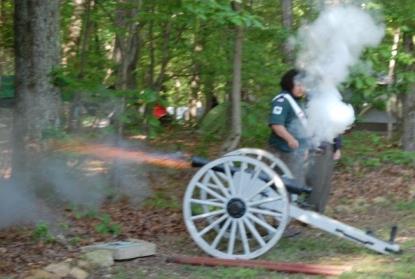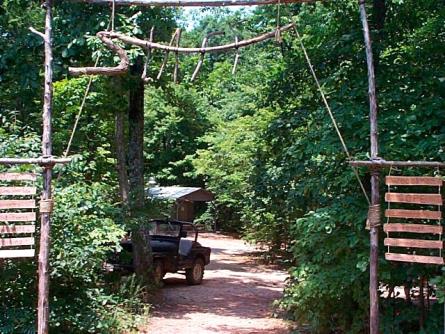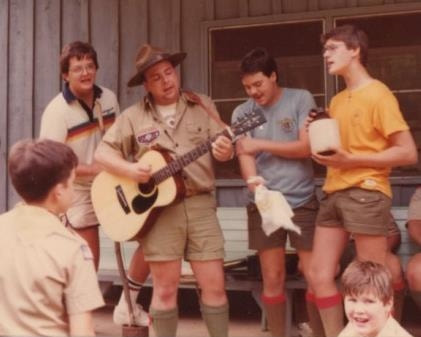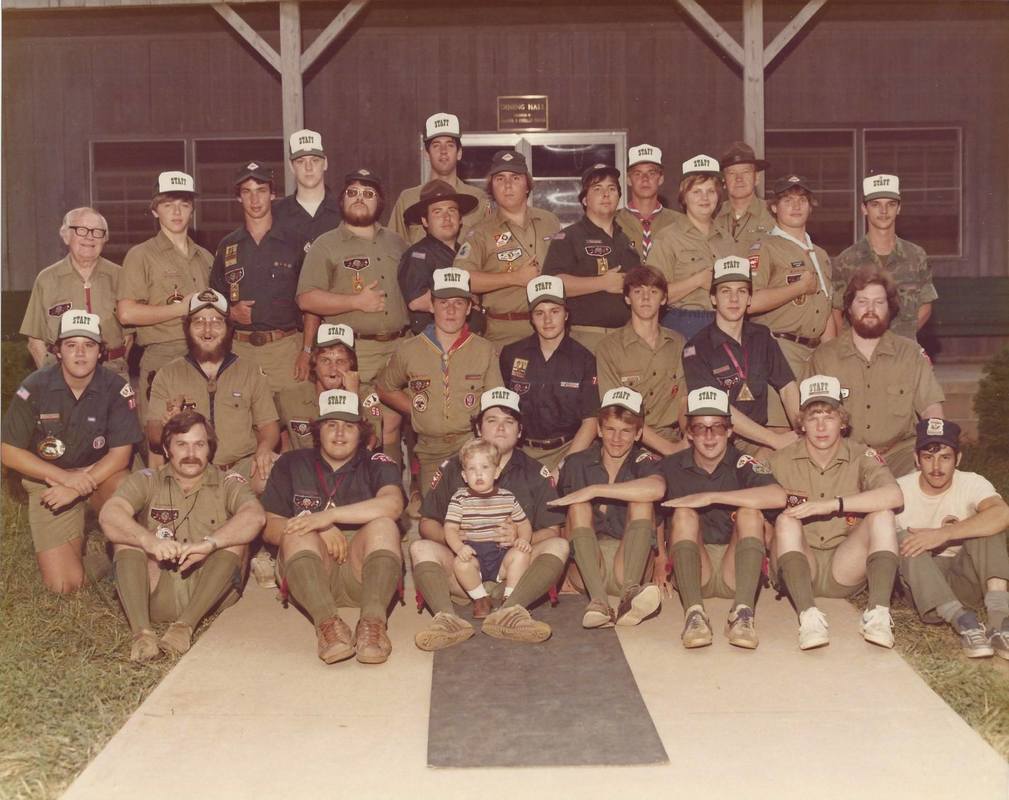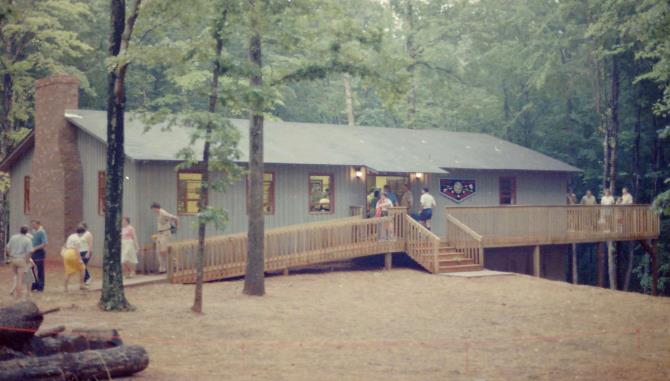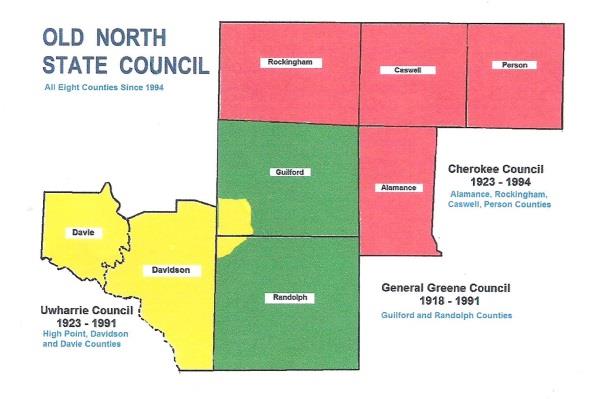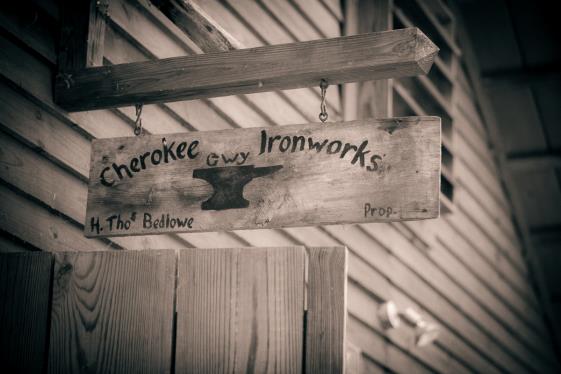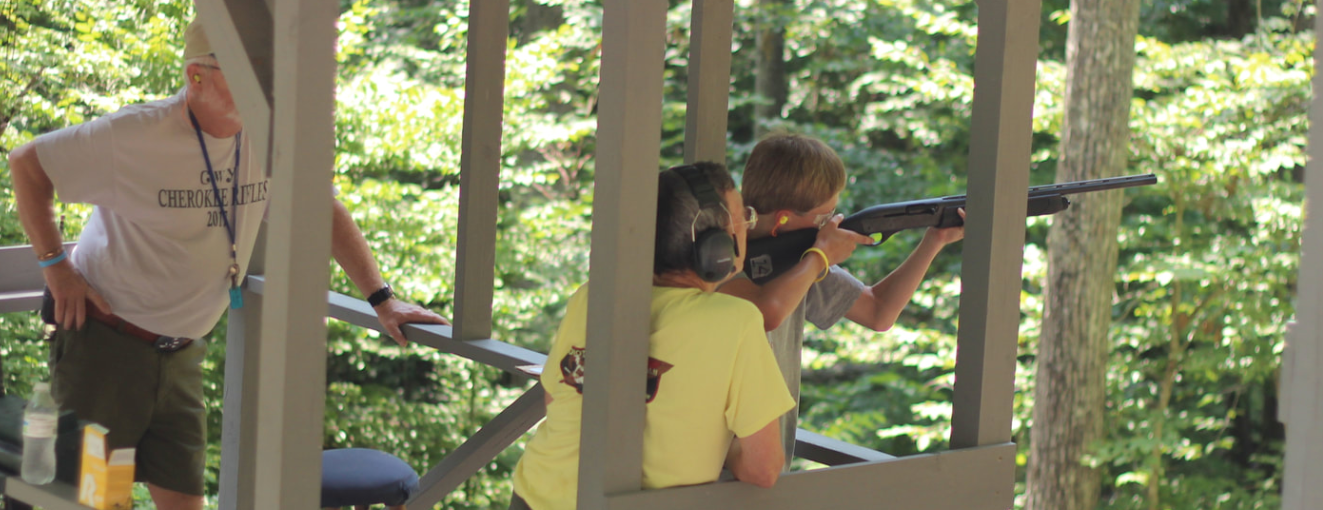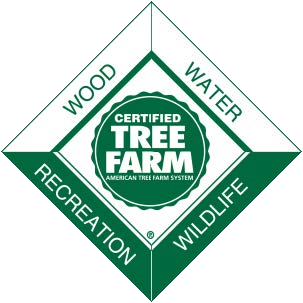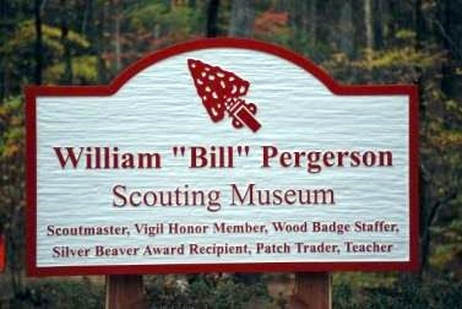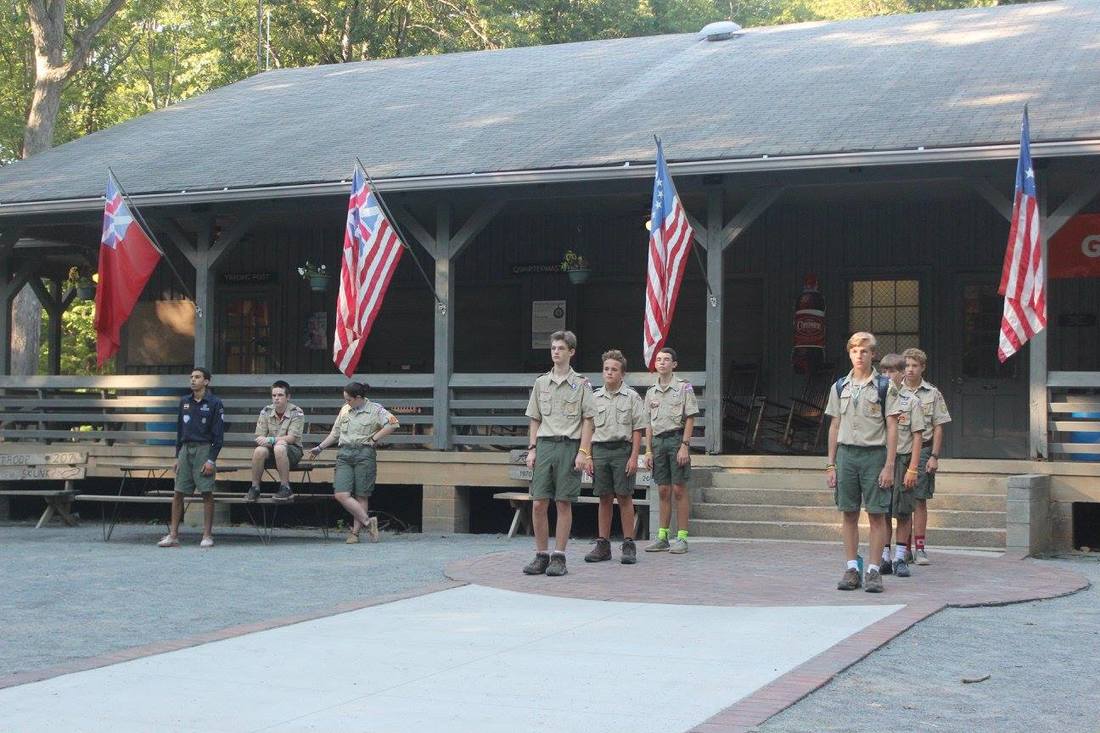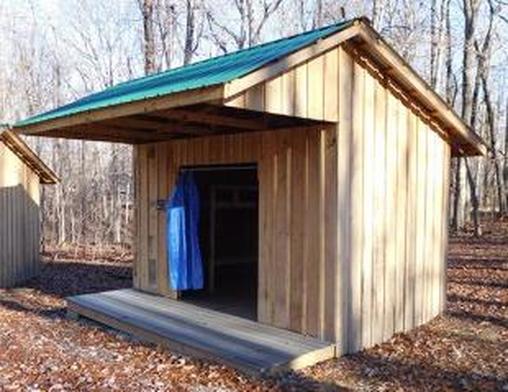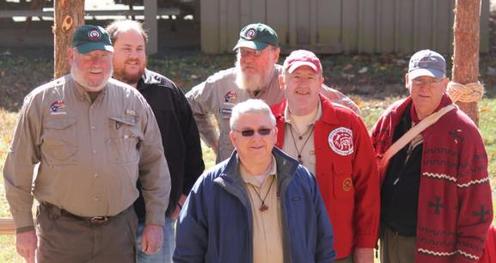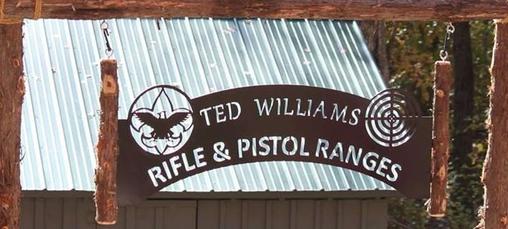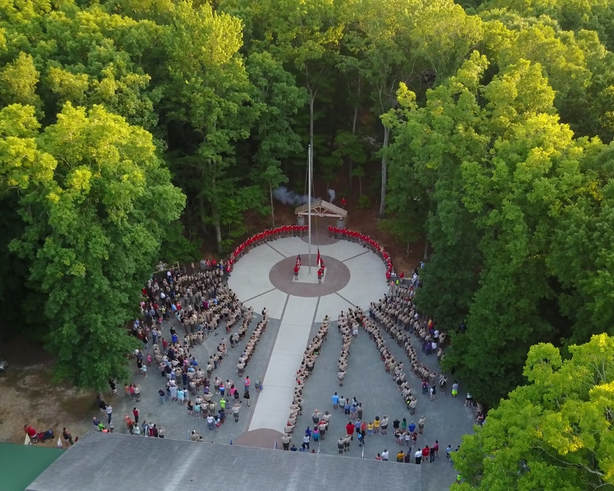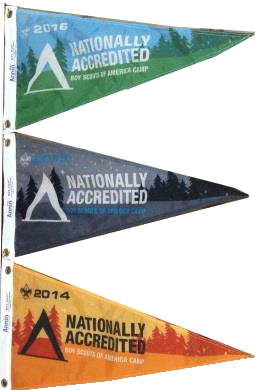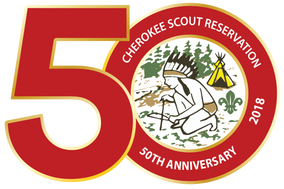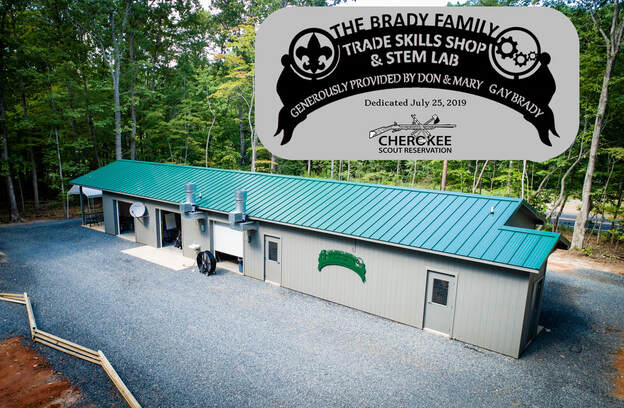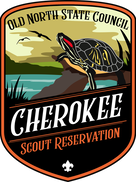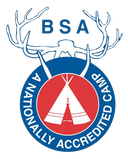For almost forty years Cherokee Council, which covered Alamance, Rockingham, Caswell, and Person counties of north central North Carolina, held its summer camp programs at Camp Cherokee located on 79 acres of land near Wentworth, North Carolina. The small intimate camp served thousands of Scouts during its history, but with the growth of Scouting in the 1960s the Council realized they needed a larger camp. The search began for property where the Council could offer a wilderness experience.
Cherokee Council’s search committee found a 1,451 acre site in central Caswell County. In addition to the rural setting it was located adjacent to extensive state game lands. The Council negotiated a very favorable price with the Bassett Furniture Co. and purchased the land in 1966.
Council leaders walked the new site and began to plan the layout of the new summer camp facility. A central part of every Boy Scout summer camp program is aquatic activities, but the property had no lake. A suitable site was found, land was cleared, and a dam was built by Sam Smith Construction to create a 26 acre lake on a stream called Nats Fork. The property was potentially to be home for three separate camps. Camp #1 became what we have today as the other two camps have not yet been developed.
Three buildings and three program shelters were the first structures built on the property. The buildings were the Commissary, Health Lodge, and Headquarters. The program shelters were all built with the same plan which included a fireplace and they are now part of FROGS, Handicraft, and the Nature Lodge.
The Council had hoped to open the new camp in 1967, but when they realized the lake would not be ready, they leased Camp W.D. Campbell located on Kerr Lake from Occoneechee Council. That year they held three weeks of summer camp as several troops visited other camps or did special week long trips.
Many Cherokee Council Scouters were sad to leave the old camp, once they saw the new property and realized its potential they became strong advocates for the new camp and helped greatly with the transition. Ted White shared something his father said about the property. It is “one of the best investments Scouting ever made.”
Cherokee Council’s search committee found a 1,451 acre site in central Caswell County. In addition to the rural setting it was located adjacent to extensive state game lands. The Council negotiated a very favorable price with the Bassett Furniture Co. and purchased the land in 1966.
Council leaders walked the new site and began to plan the layout of the new summer camp facility. A central part of every Boy Scout summer camp program is aquatic activities, but the property had no lake. A suitable site was found, land was cleared, and a dam was built by Sam Smith Construction to create a 26 acre lake on a stream called Nats Fork. The property was potentially to be home for three separate camps. Camp #1 became what we have today as the other two camps have not yet been developed.
Three buildings and three program shelters were the first structures built on the property. The buildings were the Commissary, Health Lodge, and Headquarters. The program shelters were all built with the same plan which included a fireplace and they are now part of FROGS, Handicraft, and the Nature Lodge.
The Council had hoped to open the new camp in 1967, but when they realized the lake would not be ready, they leased Camp W.D. Campbell located on Kerr Lake from Occoneechee Council. That year they held three weeks of summer camp as several troops visited other camps or did special week long trips.
Many Cherokee Council Scouters were sad to leave the old camp, once they saw the new property and realized its potential they became strong advocates for the new camp and helped greatly with the transition. Ted White shared something his father said about the property. It is “one of the best investments Scouting ever made.”
|
In 1968 the Council’s first event at camp was a spring camporee. Troops set up their tents along the pipeline or some troops found openings in the woods off of narrow roads used to haul out hardwood trees for lumber. Tslagi Lodge 163 of the Order of the Arrow held a tap out ceremony on Saturday night in a field by the new lake.
|
|
By summer of 1968 the lake was filled, the buildings were ready, and Cherokee Scout Reservation opened for its initial summer camp season. Bud Symmes, District Executive for Alamance District, served as Camp Director with Jim Fish serving as Assistant Camp Director. Scouts paid $21.00 to attend a week of camp that first year.
|
The new camp did not yet have a dining hall so troops cooked their meals in their campsite “jamboree” style. Several campers from those first years talked about the process. Each morning each patrol sent a Scout to the Commissary building. The Scout wore a pack frame with a plastic trash can attached by bungee cords. The quartermaster would give the Scout the food allocated for his patrol. The Scout carried the heavy load back to the campsite where other Scouts had built a fire in their shepherd’s stove. The food was prepared and everyone ate their meal. After the meal someone did “kp” cleaning the dishes and throwing away the trash. This whole process could take up to two hours for breakfast or supper. There was usually less cooking at lunch.
Scouts enjoyed visiting the waterfront for swimming and boating, but some complained about the distance to the lake taking the camp road. Soon Scouts began exploring camp and finding short cuts across the property. Their initial trail blazing developed some of the trails Scouts still use today.
Scouts enjoyed visiting the waterfront for swimming and boating, but some complained about the distance to the lake taking the camp road. Soon Scouts began exploring camp and finding short cuts across the property. Their initial trail blazing developed some of the trails Scouts still use today.
Program areas were not yet built. The handicraft director operated out of a patrol box. The supplies and tools needed to make a lanyard, carve a neckerchief slide or make a basket were all contained in one small box. Scouts sat on the porch of the Commissary working on their crafts. The Nature program was taught at the shelter on the way to the waterfront (now FROGS).
During the summer of 1969 the United States space program was attempting to visit the moon. As a Scout, Dale Weber remembers listening to a portable radio in his tent when Apollo 11 blasted off from Cape Kennedy in Florida. The next Sunday the Scouts at camp all sat on the grass in front of the Commissary porch and watched a black and white television a staff member brought to camp. They watched Eagle Scout Neil Armstrong be the first man to step foot on the moon.
During the summer of 1969 the United States space program was attempting to visit the moon. As a Scout, Dale Weber remembers listening to a portable radio in his tent when Apollo 11 blasted off from Cape Kennedy in Florida. The next Sunday the Scouts at camp all sat on the grass in front of the Commissary porch and watched a black and white television a staff member brought to camp. They watched Eagle Scout Neil Armstrong be the first man to step foot on the moon.
|
Staff members told campers stories about the new camp they were now using. A popular topic was the “Old Hermit” that lived in a cabin back in the woods on the other side of the lake. When some of the Cherokee Council Scouters initially walked the property he supposedly shot his gun at them. He did not like visitors. The old man died before camp was open and this was the source for many a ghost story told around the campfire. Some Scouts reported sleeping in that cabin and later some adults received permission to move the cabin to camp. The cabin was disassembled, logs labeled, and the pieces were moved to camp. Unfortunately, before the cabin could be rebuilt several of the logs began to rot and became the home for termites, small rodents and snakes.
|
|
After several years of jamboree cooking the Council began building a dining hall. Tslagi Lodge was hosting the Area 6A Fellowship at Cherokee Scout Reservation in April 1973. The goal was to finish the dining hall and to use it to serve meals to the 500 Order of the Arrow members visiting from across the state. Keith Christopher remembers the gas in the kitchen was not hooked up until an hour before the delegates began to arrive.
The camp hired school cafeteria workers to cook meals for summer camp. A leader of the kitchen for many years was Mrs. Henderson. Ted White, a staffer from 1971 – 1976, shared several stories about this fine lady. It seemed the staff was always hungry and there was never enough food to fill them. Mrs. Henderson was a talented cook and could make anything taste great. The staff started catching rabbits and turtles and once the Scouts cleaned the animals she would cook them. Mrs. Henderson refused to cook a snake but about anything else was fair game! |
Ted Broussard, retired Air Force, was known as “Big Ted”. He served as Business Manager in the 1970s, then Camp Director for the summer of 1975. Several former staff members gave him credit for bringing great improvement to camp through his leadership of the staff. He motivated people to do their best.
The 1975 Business Manager was a guy who grew up in the area, went to High Point College and joined the Cherokee Council staff as a District Executive in 1972. Ted Williams was a professional Scouter who spent most of his career serving a key leadership role in the development of Cherokee Scout Reservation and its dedicated staff.
Mike Walters shared the following memory:
Cherokee in the 70s was a little different. Camp ran for 5 weeks from early June to the first of August back then with a staff week before and after. Teddy Wayne directed a staff of about 18-20 in number. The dining hall was in its infancy, about half the size of today, camp had to be set up (from ground up) the first week, and packed up the last. There were no computers, cell phones or video games back then, such that the staff had to rely on their imaginations, and believe me, they were imaginative. A big week was just under a hundred campers. I recall one week of only 20+ campers, now that was a fun week!
The 1975 Business Manager was a guy who grew up in the area, went to High Point College and joined the Cherokee Council staff as a District Executive in 1972. Ted Williams was a professional Scouter who spent most of his career serving a key leadership role in the development of Cherokee Scout Reservation and its dedicated staff.
Mike Walters shared the following memory:
Cherokee in the 70s was a little different. Camp ran for 5 weeks from early June to the first of August back then with a staff week before and after. Teddy Wayne directed a staff of about 18-20 in number. The dining hall was in its infancy, about half the size of today, camp had to be set up (from ground up) the first week, and packed up the last. There were no computers, cell phones or video games back then, such that the staff had to rely on their imaginations, and believe me, they were imaginative. A big week was just under a hundred campers. I recall one week of only 20+ campers, now that was a fun week!
|
Another key person for the success of the young camp was Ranger Russell Lee. He was a native of the area, very active in the community, a former Scoutmaster and longtime volunteer. He had a steady hand of leadership first learned as a Marine Corps sergeant in the Pacific during World War II. Russell knew how to use his resources: Scouters, neighbors and friends to help build the new camp. He served as Camp Ranger for twenty years and managed the property well leading to its long-term success.
|
|
The United States celebrated its 200th birthday in 1976. As part of the Bicentennial celebration OA leader, Tommy Murray, borrowed a cannon to fire on the 4th of July. The cannon was made by a local guy for use in Civil War re-enactments and only Tommy could load and fire the cannon. For over 40 years Scouts and Scouters, families and friends have jumped at the firing of the cannon during the evening flag ceremony.
|
Tslagi Lodge 163 of the Order of the Arrow played an important role in the development of Cherokee Scout Reservation. The lodge provided thousands of hours of service in maintenance of camp during workdays and ordeals. Most of the camp staff were OA brothers. In 1974 the shelter behind the Dining Hall was established as the OA lodge building. Walls and windows were added as the lodge became storage for records, regalia, and supplies. During summer camp the building sat dark during the day and a sense of mystery surrounded this home of the Order of the Arrow.
In the 1970s Council Scout troops were encouraged to help finance and build shelters in each campsite. These small shelters covered a couple of picnic tables and provided a central point in each site where troops could gather during camp to have meetings, work on advancement, or share meals.
In the 1970s Council Scout troops were encouraged to help finance and build shelters in each campsite. These small shelters covered a couple of picnic tables and provided a central point in each site where troops could gather during camp to have meetings, work on advancement, or share meals.
|
Cherokee Scout Reservation is unique amongst Boy Scout camps in that its whole summer camp staff lives in the same site. This family setting brings the staff closer together. The original staff area was located where the Dining Hall now stands. Once the Dining Hall was built the staff camped behind the Commissary in the area that is now the basketball court. When the Dining Hall was expanded in the mid-1990s the staff moved to its current home. Some people question why the staff stays in large wall tents covered with tarps and decorated with everything from pink flamingos to inflatable palm trees, but any former staff member will tell you of their fond memories of playing games, listening to music, and just sitting around camp at night, talking with their friends. There is something magical about serving on this camp’s staff.
|
Over the years a variety of nicknames have been assigned to staff members. There are certainly stories behind each name although some are long forgotten while the nicknames remain. Here are a few you may know: Grey Squirrel, Turtle Man, The Ranger, Nasty Bear, Sugar Bear, Woo Woo, Bull Frog, Nature Boy, Chunk, Crispy, … Other staff members were known by part of their name: Teddy Wayne, Gin, Ritchie, Bud, Flack, Marvin, Chaz, Murray...
Cherokee Scout Reservation received special recognition in 1980 as the camp earned a Gold Conservation
Award from the Department of Soil & Water Conservation. …
Cherokee Scout Reservation received special recognition in 1980 as the camp earned a Gold Conservation
Award from the Department of Soil & Water Conservation. …
|
In the 1980s Mike Walters served as Program Director during several summers. Mike had a reputation for taking naps in unusual places. You might find him in Scoutcraft on top of the signal tower or he was known to crawl under the counter in the Trading Post. There were stacks of t-shirts which made for a comfortable napping place. When he was awake Mike might share his love for music. He played guitar and banjo and enjoyed singing.
|
|
Ted Williams served as Camp Director for several summers during this period. His wife, Gin, also worked at camp serving in Handicraft and in the Dining Hall. Ted and Gin had two sons, Ben and Chris, who grew up spending their summers at camp. One staff member recalls Ted having the staff line up in front of the Commissary prior to the start of camp. Ted took this opportunity to show off his infant son, Ben.
In 1985 the camp staff was joined by Anders Rosander, a Scout from Sweden. This International Scout was one of a series of Scouts from foreign countries that shared some of their culture with the staff and Scouts. He enjoyed a trip to the National Jamboree being held at Fort A P Hill in Virginia. Other International Scouts at CSR during the 80s were Antonio Obergon - Mexico, Andy Hickmott - England, Stefan Rosander - Sweden. |
|
Tslagi Lodge decided to construct a new building at camp as a home for the Order of the Arrow. Arrowmen began raising funds in 1985 and the effort was highlighted by the number of Scouts that participated. Construction moved quickly and the building opened in 1986. The shelter made OA lodge building located behind the Dining Hall was now available and became the camp’s Nature Lodge.
|
In 1988 a special program was started for First Year Campers. New Scouts had a chance to work on their Second and First Class Scouting skills. That year was also Russell Lee’s 20th year of serving Cherokee Scout Reservation as Ranger. The Council held a camporee that honored him for his many years of dedicated service. He retired following the camporee and Marvin Preslar was hired to take over as Camp Ranger.
The 1990s brought continued growth in camp attendance and the addition of new programs. In 1990 a C.O.P.E. (Challenging Outdoor Personal Experience) course was built north of the parking lot. Older Scoutshad an opportunity to enjoy a ropes course and participating in team building exercises.
A new form of recognition within the staff was started in the early 90s: Staff Member of the Week and Geek of the Week. The Staff Member of the Week was recognized for going above and beyond their normal duties in Camp. The Geek of the Week was presented to a staff member that did something humorous, awkward, or clutsy.
The 1990s brought continued growth in camp attendance and the addition of new programs. In 1990 a C.O.P.E. (Challenging Outdoor Personal Experience) course was built north of the parking lot. Older Scoutshad an opportunity to enjoy a ropes course and participating in team building exercises.
A new form of recognition within the staff was started in the early 90s: Staff Member of the Week and Geek of the Week. The Staff Member of the Week was recognized for going above and beyond their normal duties in Camp. The Geek of the Week was presented to a staff member that did something humorous, awkward, or clutsy.
|
In 1994 Cherokee Council merged into Old North State Council which was formed in 1992 with the merger of General Greene and Uwharrie Council. One of the concerns of Cherokee Council members was the role of Cherokee Scout Reservation in the new council. Their support of the merger was gained through the decision to make CSR the summer camp for Boy Scouts. The council’s other large property, Woodfield Scout Preservation, would become the council’s home for the Cub Scout program.
In order to serve the Scouts of the now eight-county council some changes were needed at camp. The Dining Hall was expanded. The back wall was removed and twelve feet was added along the length of the building. A wrap-around porch was added along with doors on the north end. The kitchen was upgraded to serve the growing numbers of campers. New restrooms and hot showers were added in several locations among campsites. In more recent years several larger shelters have been built including lighting and electrical outlets for everyone to keep their technology charged. Efforts continue to improve facilities to support the high quality program that the camp provides. |
For many years Frontier Heritage Night has been a favorite of Scouts attending camp. The program got started in the 1990s when several Scouters shared their hobbies with camp. Si Rothrock, John Young, David Trull and Marvin Preslar had an interest in and learned blacksmithing skills. John Young donated his anvil and tools to camp and a program was started. Tommy Murray was a lifetime collector of long rifles and added the shooting of black powder rifles to the event. Tomahawk and knife throwing were added as activities. Each Wednesday evening during twilight Scouts can enjoy these activities as well as bullet making or try arrowhead knapping with Jerry McGuire.
|
As the 2000s arrived the Council leaders were looking for new programs for older Scouts that came to camp. One major addition was the climbing tower. Older Scouts could develop their skills at scaling the walls to the top and then enjoy rappelling down. A new C.O.P.E. course was built across Scout Camp Road financed by a grant from the Order of the Arrow. Mountain Biking was added as an activity. The first year camper program was modified and renamed FROGS (Fundamental Requirements Of Good Scouting). Automotive Maintenance merit badge was offered.
|
|
An interest in Metal Working continued at camp. What had started as a demonstration during Frontier Heritage Night now grew into a camp program. In 2005 the Metal Work Shop was built and more equipment was added. Si Rothrock and David Trull were mentors for this new program where Scouts could run a forge, heat metal and shape it with a hammer. Scouts learned both old and modern techniques of
working metal. |
|
In the fall of 2007 the Council purchased sporting clays equipment. A group of interested volunteers came together to put this equipment to use. A site was chosen and the Sporting Clays course was designed and built. It was a half-mile trail with ten shooting stations, two throwers per station. Each had a different configuration providing a challenging course for even the most experienced shooters. The Council formed a Shooting Sports Committee and brought in NRA members to train and certify range officers. At camp a pistol range was added, a unique muzzle loading course was prepared, and Action Archery was opened. Cherokee Scout Reservation has one of the best shooting sports offerings in the country.
|
|
Additional property was added and the camp now totaled over 1,700 acres. Only a few hundred acres were in use for the main camp and its program areas. Around 2003 the Council started to discuss how to best manage the 1000+ acres of forests. In 2006 a forestry consulting firm was hired to develop a forestry management plan. The company that owned the land before the Council had practiced cutting the best hardwood timber to be used in making furniture. Poorer quality trees remained and the Council had let the existing forest grow for twenty years. The new plan called for removing poor quality hardwood trees, harvesting some timber, removing inferior Virginia pines and replacing them with loblolly and short leaf pines. Areas were opened for growth of hickory and oak trees. The Old North State Council gained much positive recognition for its efforts in stewardship of its forest. In 2009 Cherokee Scout Reservation became a Certified Tree Farm. The camp was also chosen as a Model Forest, the only Boy Scout camp in the country with that designation.
|
|
In late 2008 OA Lodge Adviser Rob Kennerly asked David Pugh to put together a group to turn the basement of the Lodge Building into a museum. The idea had been around for many years and Zan Rothrock had paneled the basement’s back room several years before. The lodge contributed funds for building supplies to finish the back room. Johnny Somers, Rick Horne, Dale & Delores Weber, Larry Warlick, and John Kinney joined David Pugh and put in lots of time and loaned parts of their collections to open one room of the museum during the summer of 2009. John Young, Tommy Murray and other Scouters gave the museum items from their collections and soon exhibits filled the full basement. In 2013 the museum was dedicated and named for long time Cherokee Council Scouter, Bill Pergerson. The museum is open for visitors each Thursday night during summer camp and for other events at camp.
|
|
In 2011 the Council decided to renovate the Commissary building. Under the leadership of Jim Smith and Chris Williams the interior was redesigned with a new service area for selling refreshments. A large covered deck was added to the end of the building where Scouts can congregate during down times.
|
|
Since Cherokee Scout Reservation opened in 1968 Scouts spent their nights sleeping in canvas wall tents. They were initially set up each summer with poles and ropes. Then in the 1990s metal frames were attached to wooden platforms and tents were left up year round. In 2014 the Council Camping Committee Chairman Mickey Kluttz formed a sub-committee to look at structures to house campers during resident camp. The group toured several camps in the region that had a variety of structures. They liked a design
they found at the Knoxville, TN council camp that would use the current tent platforms as the floor system for what would be called Adirondacks. Si Rothrock developed a rough design and in June 2014 George McLarty, Si Rothrock, Mickey Kluttz and leaders from Troop 19 built a prototype Adirondack in Pawnee campsite. The structure had bunks for four youth. Leaders and campers were encouraged to tour the new Adirondack and give feedback for changes that might be made. In 2015 a contractor was hired to build 20 Adirondacks with another three being funded and built by troops. In 2016 another 29 were built by contractors and troops. In 2017 12 were added plus another 10 in 2018. This brought the total for the summer of 2018 to 76 Adirondacks. The lumber used to build many cabins was milled from trees harvested from camp forests. |
|
In an ongoing effort to upgrade camp facilities the Council developed a plan to renovate the Council Ring.
Phase I was the Flag Pole Complex. In 2016 the flag pole area was completed including the brick pavers around the flag pole. This area was designated as the Court of Eagles. Bricks are being sold for $100 each to honor Eagle Scouts. Click here for more information. |
|
In 2017 Old North State Council was recognized for its contribution to bird-friendly forest management by the NC Audubon Society. As a part of the Forest Landbird Legacy Program the camp property will be using bird-friendly practices for the next ten years.
Today, Cherokee Scout Reservation is considered one of the top camps in the South. It starts and ends with a great staff. The brightest and best Scouts and Scouters from the area work at camp each summer. New staff members each year learn during Staff Development about the high standards that are expected from those chosen to serve. The camp is inspected each summer and has a long tradition of being Nationally Accredited. You can see over 40 years of pennants hanging in the Dining Hall. One thing the camp has that most Boy Scout camps lack is a strong base of volunteers. These Scouters come back year after year to support the staff and provide extra expertise to program areas at no cost to the camp. These official and unofficial advisors share a love for the camp that comes to those that invest their time and energy into making something special. |
|
Summer 2018 marked the 50th anniversary of Cherokee Scout Reservation. In 1968, the Cherokee Council moved its Boy Scout resident summer camp from Camp Cherokee in Wentworth to Cherokee Scout Reservation in Yanceyville. Since then, Scouts from across the southeastern United States have enjoyed summer camp adventures at Cherokee Scout Reservation.
A special 50th Celebration was held at camp, and the inaugural group of Scouters were inducted into the Hall of Leadership. |
|
In 2019 Cherokee scout Reservation opened the Brady Family Trade Skills Shop & STEM Lab, made possible by a generous gift from Don & Mary Gay Brady. It was dedicated on July 25, 2019.
This state of the art building drew many Scouts to sign up for excellent instruction in:
|
